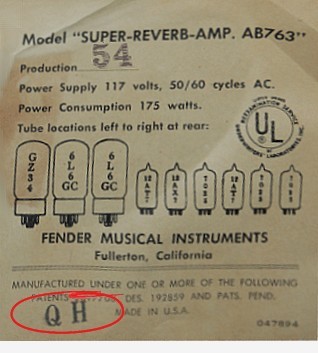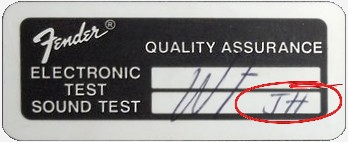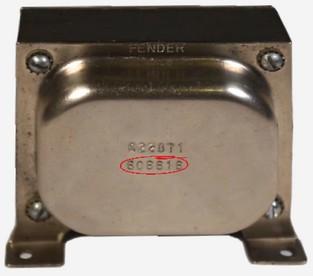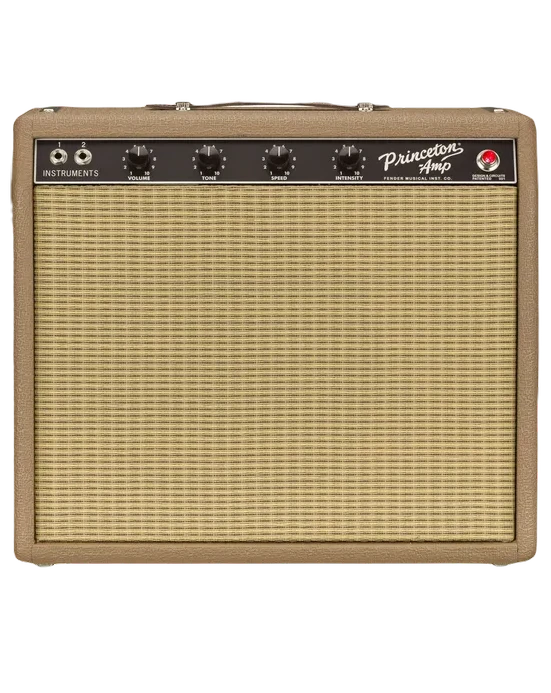It is challenging to determine the precise date of vintage Fender amplifiers made before 1994 due to the lack of adequate documentation. However, an estimated date can be approximated.
On the other hand, Fender amplifiers produced from 1990 to the present have a date code that can be found on the QA sticker located at the back of the amplifier chassis.
To determine the manufacturing year of a Fender amplifier, you can use the serial number decoder and dating system provided below.
Table of Contents
Table of Contents
Where to find Fender Amp Serial Number (CHASSIS)?
In older versions, the serial number is stamped on the right-hand side of the chassis. However, in newer models, the serial number is presented on a sticker.

Fender Amps Serial Number Vintage 1951-1969
On the inside of the cabinets of Fender amplifiers that were built after 1950 and before 1970, a sticker is generally attached. This indicates the type of the tubes used and their location on the chassis. Also on this sticker stamped 2 letters (sometimes handwritten) indicating a date code.


Fender amps Date code from 1951 to 1969 Chart
| Letter Code | Year | Month |
|---|---|---|
| A | 1951 | January |
| B | 1952 | February |
| C | 1953 | March |
| D | 1954 | April |
| E | 1955 | May |
| F | 1956 | June |
| G | 1957 | July |
| H | 1958 | August |
| I | 1959 | September |
| J | 1960 | October |
| K | 1961 | November |
| L | 1962 | December |
| M | 1963 | – |
| N | 1964 | – |
| O | 1965 | – |
| P | 1966 | – |
| Q | 1967 | – |
| R | 1968 | – |
| S | 1969 | – |
Fender Amps Serial Number Since 1990
All Fender amplifiers manufactured from 1990 until now, have a date code printed on the quality assurance (QA) sticker on the rear of the chassis. This black-silver sticker shows the signatures or initials of employees after the finished noise and electrical tests. The last line also has a stamped or handwritten 2-letter date code. Handwritten is sometimes difficult to read (see image). The first letter is the year and the second letter is the month.

If no QA or tube location sticker is found or it is bad read, look at the rear of the chassis on the right side where a chassis number is punched. You can decipher the year of construction using the date decoder.
Fender amps Date code Since 1990 Chart
| Letter Code | Year | Month |
|---|---|---|
| A | 1990 | January |
| B | 1991 | February |
| C | 1992 | March |
| D | 1993 | April |
| E | 1994 | May |
| F | 1995 | June |
| G | 1996 | July |
| H | 1997 | August |
| I | 1998 | September |
| J | 1999 | October |
| K | – | November |
| L | – | December |
| M | – | – |
| N | – | – |
| O | – | – |
| P | – | – |
| Q | – | – |
| R | – | – |
| S | – | – |
Dating Fender Amps by Label and Logo
Some Fender Amps indications that you can also recognize the production year:
- Before the CBS era (before 1965) Blackface amplifiers were feature labeled “Fender Electric Instrument“. Blackface amplifiers from 1964 and some from early 1965 did not have the Fender logo on the grill cloth.
- After the acquisition of Fender by CBS in January 1965, amplifiers were labeled as “Fender Musical Instruments“.
- The logo on the grill cloth of the amplifier also indicates when it was produced. A logo with a tail is from before 1973. After 1973 the logo was tailless. With few exceptions. As long as there was a stock with tail logos, they were used randomly in 1973. Amplifiers from that year and perhaps also in 1974 can therefore have the new or old logo: tailless (after 1973), with tail (before 1973).

- There are some amplifiers from ‘68 and ‘69 announced, including the Vibro Champ and Bassman, which also had a tailless logo. However, these logos are made of plastic and slightly smaller than the metals.
Dating Fender Amps by Components
If there are no sticker or chassis numbers at all, then the components can also offer a solution for dating the year of construction of the amplifier. Assuming the components are original and have not been replaced.
Dating Fender Amps by Transformer
With the help of the EIA (Electronics Industry Association) number on the transformer, the production date can be determined. This is not the production date of the amplifier, because the transformer has already been made before and may have been for a while in storage.

The EIA number on the transformer that Fender has used the most starts with 606, followed by 3 or 4 digits. 606 is the manufacturer (Woodward-Schumacher), but a transformer from another manufacturer may also have been used.
With 3 digits, the first digit is the last digit of the decade of the 20th century. The last 2 digits are the week of that year. At 4 digits, the first 2 digits are the year of the 20th century.
Example: 606 6849 is 1968 week 49. If the production date of the transformer is now known, add at least 6 months to the production date of the amplifier. From the example, the amplifier could have been built in 1969.
Dating Fender Amps by Speakers
What applies to the transformer also applies to speakers.
Fender used Jensen speakers until 1972. In that year the Jensen production was transferred to Rola (Rola was already a part of Jensen). When Rola started making speakers for Jensen in 1972, Rola also used Jensen’s EIA code in the beginning (220). At the end of 1972, Rola changed the code to 285.
CTS Speakers.
Sometimes Fender used CTS speakers in the 1960s. Between the mid-1960s and early 1970s, the CTS 10-inch Alnico was regularly used in Super Reverbs.
Eminence Speakers.
Eminence (founded in 1966 by former CTS employee Bob Gault) made speakers especially for Fender according to those specifications. From the early eighties, these were standard in almost all tube amplifiers.
Utah Speakers.
Even though the Utah speakers from the 50s and 60s were of very good quality, Fender did not use them much during that period. It was not until the 1970s that these speakers became more widely used.
However, not all speaker manufacturers work with an EIA code.
For example, Celestion has its date coding method that consists of 2 letters with 1 or 2 digits.
Examples:
GK12 is July 12, 1977;
23HA is August 23, 1956, or 1968.
Dating Fender Amps by Potentiometers
In the 1950s, Fender mainly used potmeters from the Stackpole brand (304). Halfway through 1963, the switch was made to the CTS brand (137). In 1967 Fender bought a very large stock of CTS and was used for over 5 years. Fender amplifiers and guitars made in 1973 can therefore still have the 1967 potmeters with EIA numbers from the stock that was purchased in 1967. From 1974 a potentiometer with pressure-pull switch was added to some amplifiers. More manufacturers can be found with the EIA factory decoder by searching on their EIA code or in the component list.
Please note, old Fender Amps may look old, but are not. For example, speakers, potentiometers, or transformers may have been replaced, or the coating of the amplifier/cabinet is renewed (re-tolex).
Tolex is the flexible and waterproof vinyl material with which the cabinet or amplifier is covered. These ‘adjustments’ do not have to hurt quality, provided that the electronic components have been replaced with the correct values and requirements.
Fender Amps Production Dates by Models
| Model | Introduction | Discontinued |
|---|---|---|
| Bandmaster | 1953 | 1974 |
| Bandmaster Reverb | 1968 | 1980 |
| Bassman | 1952 | 1977 |
| Blues Deluxe | 1992 | 1999 |
| Blues Junior | 1990 | > |
| Bronco | 1967 | 1981 |
| Champ | 1948 | 1982 |
| Concert | 1960 | 1965 |
| Concert II | 1980 | 1987 |
| Deluxe | 1948 | 1966 |
| Deluxe Reverb | 1964 | 1979 |
| Deluxe Reverb II | 1982 | 1986 |
| Harvard | 1955 | 1963 |
| Hot Rod Deluxe | 1996 | > |
| Hot Rod DeVille | 1996 | > |
| Princeton | 1949 | 1979 |
| Princeton Reverb | 1964 | 1981 |
| Pro | 1946 | 1965 |
| Pro Junior | 1993 | > |
| Pro Reverb | 1965 | 1982 |
| Prosonic | 1996 | 2002 |
| Reverb Unit | 1961 | 1966 |
| Showman | 1960 | 1993 |
| Super | 1947 | 1963 |
| Super Reverb | 1963 | 1982 |
| Tremolux | 1955 | 1966 |
| Twin | 1948 | appeared in several variants until 2012 |
| Tube Reverb | 1976 | 1978 (reissue 1994-2016) |
| Vibrasonic | 1959 | 1964 |
| Vibrolux | 1964 | 1982 |
| Vibro Champ | 1964 | 1982 |
| Vibrosonic Reverb | 1972 | 1982 |
| Vibroverb | 1963 | appeared in several variants until 2008 |
| White Amp | 1954 | 1962 |
I’ve spent my whole life playing through “heavy” amplifiers, but I vividly remember the moment when a Fender Frontman arrived at my local music store. I’m not sure why I decided to try it, but it completely changed my perspective on guitar sound. It marked a new chapter in my evolution regarding what I expect from my amplifier’s tone.
